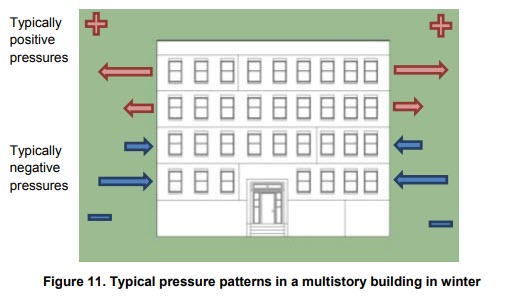Admittedly, this is a question I also had back in my apartment days. It was nice to be lucky enough to live in apartments that actually set up proper bathroom vents that worked and were well-maintained, but considering you’re in a building full of apartments, how do you know smoke, dust, and debris from other apartments doesn’t get shunted into yours? How do bathroom vents actually work in apartments?
These are good questions, and they seemed to go from general curiosity to extremely important during the initial outbreak of Covid. Vent systems in apartment buildings work in the same way, although admittedly the vents in newer buildings tend to work better and more efficiently than those in older ones, but the concept is the same.
Apartment vents use common shafts with powerful fans to create wind currents that head out of the building with very little “drift” into other apartments when it’s working efficiently. Some of this is engineering, some is science, but the design works well and we will dive into it more in the following sections.

Understanding How Apartment Bathroom Vents Work
Apartment bathroom vents work by sucking air up from the bathroom via an individual duct into a common duct that runs through the building. That common duct will be designed to have a strong fan moving air through, shoving the old air out and fresh air in. Good designs minimize circulation so it reduces the chance of smoke, droplets, or anything else coming through.
The key here is the term “minimize.” The truth is that in most apartment complexes the air from some apartments will leak through to others. How much depends on things like the pungency of smell, the modernization of the system, and the effectiveness of the sealant used on various parts of the bathroom vent system.
That is the basic structure of how it works. When it comes to the specific styles or types of ventilation systems that are most common in apartments there are three main design layouts that are common in modern apartment buildings:
- Mechanical Ventilation
- Natural Ventilation
- Hybrid Ventilation
These three styles of ventilation are common throughout apartment complexes and more thoroughly describe how ventilation happens, though not all of them apply specifically to this question.
Mechanical Ventilation
This is the most common ventilation system and it’s the one that is attached to most apartment bathrooms, especially when the design of the apartment is a new build or up to standard code. Mechanical ventilation in apartment bathrooms involves fans, ducts, and the special use of climate controlled air and designed air flows to bring in good air and pull the moisture, smells, and bad air out.
Sometimes it works well, sometimes it doesn’t, but no system can be 100% effective so there will still be leakage.
An overly simplified way of how ventilation works in apartment bathrooms then can be summarized as thus:
- Fresh air is brought in through a fan that blows through the central vent in the building, creating a sort of wind tunnel
- The fan on the other side creates a loop so all air entering that tunnel leaves through one side or the other
- Side vents go to each apartment’s bathroom – the engineering and angling should be designed to air sucks out of the bathrooms into the central vent, but central vent air does not spill into the individual bathrooms
- Turning on the fan or ventilation in the apartment pulls out bathroom air into the central vent where the designed wind tunnel takes care of the rest
Natural Ventilation
This is a basic system of ventilation that is opening windows or wall fans for allowing air flow. Obviously airing out the house is always great but this has nothing to do with the common apartment bathroom vent unless you live in a building with a really unusual design.
Good for pleasant spring or autumn days, but you are on the right out of school budget if you are living in an apartment complex with just natural ventilation.
Hybrid Ventilation
This attempts to create more natural air as part of the process of using mechanical ventilation so fresh air comes in but the pulled out air from one apartment isn’t recycled into others. This often looks very similar to mechanical ventilation in concept but might bring in extra ducts or air low but still works on the same basic principles.
Why Can I Smell Smoke or Microwaved Fish in the Apartment?
The most common example of proof that ventilation isn’t perfect is that strong or pungent smells can come in from one apartment to another. Pot smoke, strong curry smells, or strong microwaved fish smells are major examples.
While hopefully you aren’t smelling these through walls and vents in your bathroom, it does explain how smells can move from one apartment to another, but if everything is working properly it should be a relative rarity.
Bathroom vents and fans are also more effective when turned on. This pulls air out or HVACs are in depending on the vent, but when nothing is active then those are just gaps that aren’t actively pulling or pushing air into the vents as intended for the ventilation system to work.
This isn’t necessarily a failure of the vent system, but in older apartments especially, or if you have a deck/balcony and the neighbors like to keep the balcony doors open or partake of the ganja outside, then that could very well be the source of the smell as well as where it is leaking in from.
In Conclusion
While the actual engineering can be hard to understand for those of us who are not naturals at the field, but the short TL;DR version of the answer to how bathroom vents work is that they are designed so air pulled from an apartment is pulled up into a common air shaft where the fans and air flows are designed to pour the pulled air out of the building at a speed and force that prevents that air pulled from one apartment to be sent into another.
While it’s never going to be 100% (because the thought of living in an air-tight sealed apartment should be terrifying), modern systems both in HVAC engineering design, powerful fans, and the use of filters do an admirable job.
Other Bathroom Articles You May Enjoy
